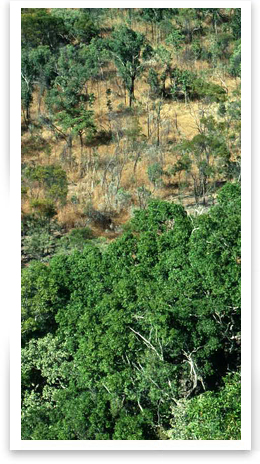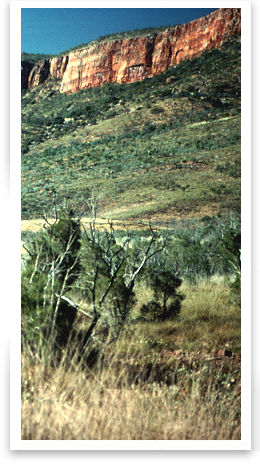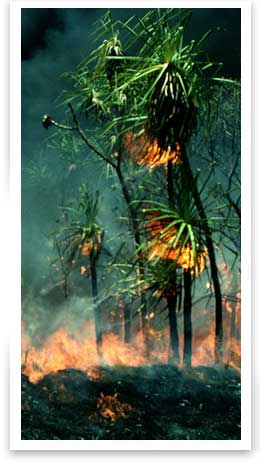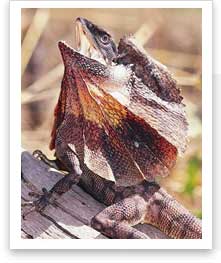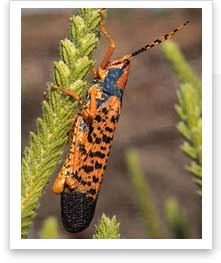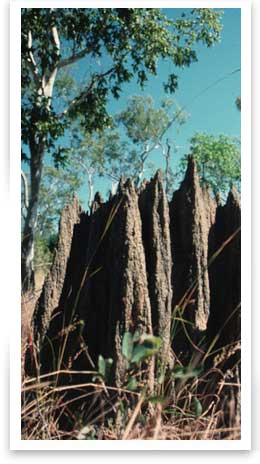Determinants
Savanna Vegetation: tree-grass persistance
We now know that savannas have a nearly continuous, well-developed grass layer and an open, discontinuous layer of shrubs or trees.
But why does a savanna have this vegetation structure? How do the two vegetation components – grass and woody plants – co-exist, without one of them dominating the other? What mechanisms determine the grass/tree ratio, and how is this ratio affected by disturbance?
Look at these two photos of Humbert River in the Victoria River District in 1933 and 1995 . Notice the increase in density of woody vegetation at this site over the 50 year period. What factors would have determined the savanna physiognomy that occurred in 1933, and what changes would have led to the ‘thickening’ of the woody vegetation?
These questions will be addressed in this module on ‘Savanna Determinants’. Let’s now explore the major factors determining both the structure and function of the world’s savannas.
Savanna Structure and Function
The sustainable use of savanna ecosystems requires an understanding of basic savanna ecology – in particular, those environmental factors that determine their structure and function, and their susceptibility to disturbance. Savanna researchers have been particularly interested in trying to determine how much we can use a savanna before it changes and how much a savanna can change and still recover its original composition? (Frost et. al. 1986). These questions lie at the heart of sustainable savanna management.
As a consequence, savanna researchers have focused on the developing a predictive understanding of the ways in which savannas respond to natural and anthropogenic stresses and disturbances (Frost et. al. 1986).
Evidence suggests that four key environmental factors are responsible;
- plant available moisture (PAM),
- plant available nutrients (PAN),
- fire regime, and
- herbivory.
So, before we investigate a range of savanna models that have been proposed, let’s first have a look at the influence of these environmental factors.
Plant Available Moisture (PAM)
The correlation between savanna occurrence and climates with strongly seasonal rainfall patterns is a clue that water availability is a key factor affecting savanna ecology.
Water availability at a site will depend on the annual rainfall, water infiltration capacity, evapotranspiration, soil texture and the hydrologic regime at the site. Unfortunately, this is difficult to quantify so in order to get an insight into the influence of water availability on savanna structure, we will compare sites with large differences in rainfall, but similar in other characteristics such as soil type.
![]()
Activity 2.6
Vegetation along a rainfall gradient
Rainfall decreases markedly with increasing distance form
the northern coast of the NT. This decrease essentially reflects the
decreasing
influence of the Australian summer monsoon as we move south. Compare
the 2 sites’
annual rainfall below:
- Site
1
Darwin
Annual rainfall ~1700 mm
- Site
2 Kidman
Springs
Annual rainfall ~600 mm
What are the main features of change in the vegetation strike you from these photos?
![]()
There is a striking change in the structure of the savanna along the declining rainfall gradient. As rainfall decreases, so too does tree density, tree height, canopy cover and woody species richness.
It is not apparent in the photos but the dominant grass life form changes from annual to perennial.
At the Darwin end of the gradient:
The vegetation is dominated by Eucalyptus overstorey and a grass understorey of annual and perennial tall-grass species.
- Tree height is approximately 15m – 20m
- Canopy cover is approximately 50%
- A shrubby midstorey layer exists
- High woody species richness
At Kidman Springs end
- Vegetation is mainly perennial grass cover with scattered trees
- Tree height is approximately 5-8m
- Tree densities are low with canopy cover of approximately 10-20%
- Low woody species richness
Plant Available Nutrients (PAN)
Nutrient availability is largely a function of soil moisture and dry season nutrient uptake and nitrogen mineralisation in particular, is limited by low levels of PAM. Significant plant growth is only possible during periods of high PAM that releases available nutrient via mineralisation.
Soils of semi-arid savanna can have a higher intrinsic fertility when compared to highly, leached soils of mesic sites, but this nutrient capital is only available for uptake during moist periods.
Savanna vegetation receiving similar rainfall can exhibit contrasting structure and floristics, simply due to fine-scale changes in soil type. A good example of this interaction comes from the long-term savanna research site of Nylsvley in South Africa; here, nutrient-poor, broad-leafed savanna, dominated by Burkea africana¸ surround patches of nutrient-rich soil that support a very different savanna type, a fine-leafed savanna dominated by Acacia tortilis.
| The overstorey of the nutrient-poor savannas are dominated by Burkea africana. These trees are broad-leafed with dimensions of greater than 2cm. Few species in this community have thorns or prickles. Tree canopy heights are approximately 4.8m. | |
| The overstorey is dominated by fine-leaved Acacia tortilis and A. nilotica. Dominant trees have leaflets about 2mm long, and are conspicuously thorny. Tree canopy heights are 4.3m. Tree cover is also sparser and less diverse than in the poor-nutrient savanna. Productivity of the fine-leafed savanna is approximately double that of the broad-leafed system and attracts a larger grazing and browsing fauna. |
Fire
Ignition and Extent
Fire is an important landscape-scale determinant that impacts all of the world’s savanna.
Fire is an inevitable consequence of the annual cycle of profuse herbaceous production during the wet season followed by curing of this material in the dry season, when climatic conditions are ideal for burning.
Prior to human occupation and use of fire in savannas, lightning would have been the dominate source of ignition and it is likely that extensive but infrequent fires would have occurred. In Australia, humans have intentionally used fire for at least 40,000 years and in Africa for potentially 1 million years or more.
Large proportions of savanna regions are burnt each year for a variety of reasons; land clearing, livestock management, property protection, conservation management and cultural purposes.
In African savannas, fires burn between 25 to 50% of the arid "Sudan Zone" and 60 to 80% of the humid "Guinea Zone" each year. Approximately 65% of Eucalyptus dominated savanna woodland and 50% of savanna open forest in Kakadu National Park, northern Australia was burnt annually between 1980 and 1994.
![]()
Activity 2.7
Characteristics of fire regimes
Are all savanna fires the same? With reference to the following, describe the main characteristics of fires in the early dry season and late dry season?
- Williams, R.J., Gill, A.M. & Moore, P.H.R. (1998) Seasonal changes in fire behaviour in a tropical savanna in northern Australia. International Journal of Wildland Fire 8: 227-239.
- Hutley, L. B. and Setterfield S. A. (2008) Savannas. In S.E. Jørgensen and B. Fath (eds.) Encyclopedia of Ecology, Elsevier, Amsterdam.
![]()
With the progression of the dry season, fire intensity increases due to fuel accumulation from curing litterfall and grass senescence resulting in an increased combustibility of fuels plus more severe fire weather (i.e. higher temperatures, stronger winds and lower humidities). Early dry season fires (when fuel accumulation is low and curing incomplete) tend to be low intensity, patchy and limited in extent. Fires later in the season are of higher intensity and produce more extensive and homogeneous burning.
Impact on plant recruitment
Fire has a major role in restricting tree establishment and growth, as evident from long-term fire exclusion plots (> 25 years) in southern African and north Australian savanna which have resulted in a woody thickening.
Frequent fire events can reduce tree seedling establishment and the ability of saplings to escape the flame zone via height growth. This limitation on tree establishment enables grass persistence and growth, maintaining the fuel load. The aerial stems of small seedlings and suckers are often killed during fire but the individuals are able to resprout from lignotubers or from other underground and stem basal tissues.
Seedlings less than 6 months old have been observed to resprout in some species (e.g. Eucalyptus miniata) and frequent fire in the savannas will kill or maintain tree seedlings as a suppressed woody sprout layer until there is a sufficient fire-free period for them to escape the fire damage zone. Species can survive for at least 40 years as suppressed sprouts, during which time they develop significant lignotubers which aid in rapid growth during fire free periods.
Most perennial grass species are generally unaffected by burning and regenerate from basal leaf sheaths protected underground. Some perennial (e.g Trachypogon plumosus) and annual (e.g Andropogon brevifolius) grass species decrease in abundance after a long-term absence of fire.
![]()
Activity 2.8
Effect of fire regime on seedling regeneration
What aspects for fire regime determine the effect on seedling regeneration of savanna trees and shrubs?
Read the following
- Setterfield SA (1997) The impact of experimental fire regimes on seed production in two tropical eucalypt species in northern Australia. Australian Journal of Ecology 22, 279-287.
- Andersen A. N. et al. (2005) Fire frequency and biodiversity conservation in Australian tropical savannas: implications from the Kapalga fire experiment. Austral Ecology 30, 155-167.
- Hoffmann, W.A. (1999). Fire and population dynamics of woody plants in a neotropical savanna: matrix model projections. Ecology 80, 1354-1369.
![]()
The timing of fires in relation to reproductive phenology can constrain or promote plant reproduction. Studies on the woody species in the Brazilian cerrado and mesic Australian savannas have indicated that frequent fire can reduce seed production and sexual recruitment and could cause a shift in species composition, favoring vegetatively reproducing species. However, fire is also important for the sexual regeneration of some species, as burning induces flowering and fruit dehiscence in many cerrado species and facilitates pollination in others.
Although some species may be unaffected by fire regime (Williams 1997), both fire intensity and fire timing are important determinants of the effect on ovule production and survival in other species. This effect is summarised in Table 2 of Setterfield (1997). In that study, high intensity fires reduced fecundity of two tropical eucalypts, whereas low intensity fires reduced the chance of the successful development of ovules, probably due to their timing in relation to ovule development.
These effects on fecundity and ovule development result in a reduction in seed production. This may, in turn, limit the establishment of seedlings in the savanna. Research at Kapalga has shown that establishment success of Eucalyptus miniata and E. tetrodonta seedlings are higher on unburnt compared to burnt sites. Therefore, the negative impact of fire on seed production will also have a negative impact on seedling regeneration.
Impact on Fauna
An animal’s response to fire is influenced by
- Its ability to survive the blaze by hiding in protected environments, or fleeing from the fire. Small mammals, such as bandicoots, are vulnerable to fire, and tree-dwelling species, such as possums, are very sensitive to high intensity fires.
- Its response to the indirect effects of the fire, including changes to shelter, breeding habitat and food supplies. Factors such as rainfall and food supplies can interact with fire so that similar fires can have different effects in different years.
![]()
Activity 2.9
The Kapalga Experiment: effect on fauna
One of the most comprehensive investigations on the effect of fire on faunal populations was conducted at Kapalga Research Station in Kakadu National Park.
Read Andersen A. N. et al. (2005) Fire frequency and biodiversity conservation in Australian tropical savannas: implications from the Kapalga fire experiment. Austral Ecology 30, 155-167 and describe the effect of the experimental fire regimes on
- Small mammals, and
- Frilled-neck lizards.
![]()
Small mammals were not adequately surveyed due to small numbers of captures during survey. However, the study showed that small mammals were the most sensitive faunal species assessed. Higher mammal densities occurred in the Unburnt catchments. Of the seven species that had enough individuals captured to undertake analysis, six were more abundant in the Unburnt catchments. This suggests that fire management needs to include long-unburnt areas to conserve this group.
Frilled-neck lizards A detailed study was undertaken at Kapalga on the effect of fire on the frillneck lizard (Chlamydosaurus kingii). Different fire regimes can affect the frillneck lizard in different ways. For instance, in lower intensity fires, their chance of survival is higher, but following higher intensity fires, the availability of prey is higher. Read Griffiths and Christian (1996) and Griffiths (1997) for a detailed description of the effect of fire on the frill-neck lizard.
Herbivory
Mammal Herbivores
Mammal herbivores are typically categorized as grazers, browsers or mixed feeders, who can vary their diet depending on food availability. The importance of herbivory as a determinant varies between savanna regions, and appears to largely reflect the abundance of large herbivores present. Large herbivore diversity and abundance are much higher in Africa than in Australia, Asia or South America.
The effects of large herbivores on savanna vegetation include
- A change in the species composition of the vegetation, e.g. grazing pressure may lead to a decrease in perennial, palatable, grazing-sensitive tussock grasses and an increase in less palatable and /or prostrate perennial grasses, annual grasses and forbs. This situation is occurring Africa and Australia.
- The density of woody vegetation may increase at the expense of herbaceous vegetation (called woody encroachment). Different mechanisms may be involved. For example, the decrease in grass biomass following grazing leads to a reduction in the number and intensity of fires, so that survival of young trees is enhanced (e.g humid savannas in Argentina (Adamoli et al 1990); Botswana (Skarpe 1990)).
- The density of woody vegetation may decrease. For instance, elephants can directly kill large trees and shrubs by pushing them over or uprooting them (Cumming 1982). Browsers, like giraffes, may slow down the growth of woody seedlings and saplings and keep them within a fire-sensitive height for decades (Pellew 1983).
- Trampling by large animals, especially those with hooves, compacts soil and degrades its structure (Winter 1990). This reduces water infiltration into the soil, and leads to increased aridity and nutrient uptake. It can also increase runoff and consequent soil erosion and nutrient removal from the system.
Insect Herbivores
While less spectacular than large browsers and grazers, insects are often the dominant group of herbivores in savannas, especially on infertile soils supporting low mammal biomass.
There is a paucity of data describing their abundance or role in these ecosystems. In a broad-leaved, low fertility savanna of southern Africa, a grasshopper biomass of 0.73kg ha-1 can consume almost 100 kg ha-1 of plant material and damage an additional 36 kg ha-1. This represents a loss of 16% of above-ground grass production.
The impact of insect herbivores on physiognomy has not been established but they are clearly important herbivores in savannas through their impact on productivity and ecosystem properties.
![]()
Activity 2.10
Domestic herbivores
What do you think is the main difference between grazing by domestic and wild herbivores?
![]()
The difference is not in the animals as such, but in the management of the livestock. Indigenous large herbivores are able to migrate in response to spatial and temporal differences in vegetation, while domestic animals are restricted in their movements. High stocking rates limit fine-scale response to vegetation heterogeneity.
Protection from natural predation and disease, supplementation with water and sometimes minerals etc. lead to higher and less variable stocking rates than in natural systems.
Theoretical Models: Current Approaches
Over the last 40 years, a range of conceptual or theoretical models has been proposed to explain the persistence of tree and grass mixtures. Contrasting models have all been supported by empirical evidence for particular sites, but no single model has emerged that provides a generic mechanism explaining coexistence.
The models can be classified into two main categories:
- Competition-based models feature spatial and temporal separation of resource usage by trees and grasses that minimizes competition and enables the persistence of both life forms. The classic example of the competition-based model was the 2-layer model proposed by Walter (1971).
- Demographic-based models where mixtures are maintained by disturbance, resulting in bottlenecks in tree recruitment and/or limitations to tree growth and grasses can persist.
![]()
Activity 2.11
The models of tree-grass persistance
Please read:
- Sankaran et al. (2005). Determinants of woody cover in African savanna. Nature 438, 846-849Sankaran et al. 2004.
- Hutley, L. B. and Setterfield S. A. (2008) Savannas. In S.E. Jørgensen and B. Fath (eds.) Encyclopedia of Ecology, Elsevier, Amsterdam.
Q1 Describe the 4 competition-based models: (a) the root niche separation model, (b) the phenological niche separation model; (c) the balanced competition model, and (d) the hydrologically driven competition-colonisation model.
![]()
(a) Root-niche separation models suggest there is a spatial separation of tree and grass root systems, with grasses exploiting upper soil horizons and trees developing deeper root systems. Trees rely on excess moisture (and nutrient) draining from surface horizons to deeper soil layers.
(b) Phenological separation models invoke differences in the timing of growth between trees and grasses. Leaf canopy development and growth in many savanna trees occurs prior to the onset of the wet season, often before grasses have germinated or initiated leaf development. As a result, trees can have exclusive access to resources at the beginning of the growing season, with grasses more competitive during the growing season proper. Given their deeper root systems, tree growth persists longer into the dry season, providing an additional period of resource acquisition at a time when grasses may be senescing. This spatial and temporal separation of resource usage is thought to minimise competition, enabling co-existence.
(c) The balanced competition model suggest that trees density becomes self-limiting at a threshold of PAM and PAN and are thus unable to completely exclude grasses. These models assume high rainfall years favour tree growth and recruitment, with poor years favouring grasses and high interannual variability of rainfall maintaining a relatively stable equilibrium of trees and grasses over time.
(d) The hydrologically driven competition-colonisation model invokes a trad-off between the competitive ability between trees and grasses for water resources, and colonization potential of the two lifeforms. In higher rainfall years, tree cover would increase.
Q2 Describe the basic premise of the demographic-based models.
![]()
Demographic-based models suggests that determinants of tree demographics and recruitment processes ultimately set the tree - grass ratios. Fire, herbivory and climatic variability are fundamental drivers of tree recruitment and growth, with high levels of disturbance resulting in demographic bottlenecks that constrain recruitment and/or growth of woody components and grass persistence results. At high rainfall sites, in the absence of disturbance, the ecosystem tends towards forest. High levels of disturbance, particularly fire, can push the ecosystem towards a more open canopy or grassland; this ecosystem trajectory is more likely at low rainfall sites.
Theoretical Models: Evidence
There is observational and experimental data to support all of the above models and it is highly likely that savanna structure and function results from the interaction of all processes.
For example, in many savannas, root distribution is spatially separated with mature trees exploiting deeper soil horizons as the competitive root-niche separation model predicts. Root partitioning favours tree growth in semi-arid systems where rainfall occurs during periods when grass growth is dormant; rainfall can drain to deep layers supporting tree components. In mesic savanna sites, root competition between both trees and grass roots in upper soil layers is apparent, contrary to predictions of niche-separation models. Mesic savannas of north Australia (rainfall > 1000 mm) are dominated by evergreen Eucalyptus tree species and during the wet season these trees compete with high growth-rate annual grasses for water and nutrients in upper soil layers (0-30 cm). However, by the late dry season, tree root activity has shifted to sub-soil layers (up to 5 m depth) and herbaceous species have either senesced or are physiologically dormant. These root dynamics suggest grasses are essentially drought avoiders but are able to compete with trees during the wet season. This system serves as an example of where both root-niche and phenological separation is occurring.
Root-niche or phenological separation models largely consider impacts acting on mature individuals, whereas demographic models include impacts of climate variability and disturbance on critical life-history stages (e.g., seedling establishment and accession to fire-tolerant size classes). Demographic models assume that savanna tree dynamics are central to savanna ecosystem functioning and that savanna trees are the superior competitors under most conditions; grass persistence only occurs when determinants act to limit tree abundance. It is clear that competition, both within and between savanna life forms, occurs and that tree abundance is moderated by climate variability and disturbance. A more comprehensive model would integrate both competition and demographic theories to yield a model in which competitive effects are considered for each life-history stage.
Next topic - Major threats to savanna ecosystems
Topics in this module
